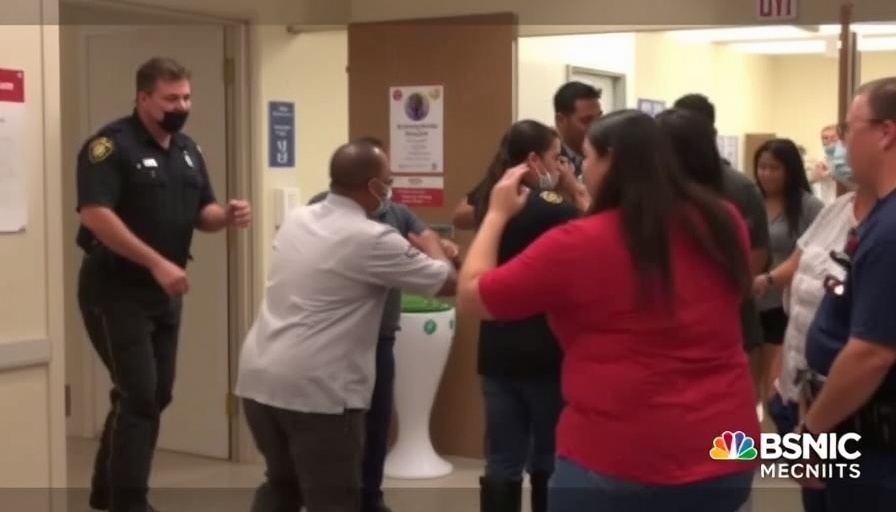
Felony Charges Dropped: A Turning Point for Medical Staff in Ontario
In a notable legal development, felony charges have been dismissed against two medical center employees involved in a tense encounter with federal agents during a July immigration enforcement operation in Ontario, California. Jose de Jesus Ortega and Danielle Nadine Davila, both staff members at an Ontario surgery center, still face misdemeanor charges stemming from the incident captured on video.
The Incident Explained: A Day of Chaos in Ontario
The altercation occurred on July 8, when ICE officers were executing immigration enforcement actions at a surgery center located roughly 50 miles east of downtown Los Angeles. As the officers pursued a truck into the center's parking lot, chaos erupted, leading to a series of events that escalated tensions between federal agents and medical personnel. Two men within the truck fled the scene, while a third, identified as a man from Honduras illegally residing in the U.S., was partially detained at the center’s entrance.
Ortega and Davila intervened during the arrest, an act which the U.S. Attorney’s Office later described as obstructive. According to official reports, video footage showed Davila placing herself between an officer and the detained man, while Ortega allegedly grabbed onto an officer's vest in an attempt to prevent the arrest.
Perspectives from the Frontlines: A Call for Understanding
Both Ortega and Davila have stated that they were merely following what they believed to be their duty when they assisted a person who had rushed into their workplace in distress. They described a scene where fear and confusion reigned as masked individuals, later identified as federal agents, pursued the man into their office. "We were just trying to do our jobs," Ortega explained, highlighting the immediate concern for the individual who sought help. Their actions stemmed from a deeply held belief in advocating for the protection of individuals who may find themselves vulnerable.
Davila, a mother herself, expressed her conviction that she did what was righteous at that moment. Her attorney, Oliver Cleary, reflected on her motivations. He reiterated that Davila acted with compassion, driven by an instinct to protect and to question the legitimacy of the government’s intrusion. “In her words, she felt that she did what was right,” Cleary noted, emphasizing the emotional turmoil faced by those working in health care settings amid immigration enforcement.
Local Reactions: The Community's Heart
The unfolding situation has not only legal ramifications but has also ignited a broader community dialogue about immigration, rights, and the responsibilities of healthcare professionals. In communities like Bakersfield, where many families share immigrant backgrounds, the tension surrounding immigration enforcement can feel especially immediate. Supporters and advocates for immigrant rights are rallying around Ortega and Davila, viewing their legal battles as emblematic of larger systemic issues.
The impact of such incidents stretches beyond the courtroom, influencing the daily lives of families grappling with the complexities of immigration policies and the implications for their loved ones. Many community members express concern about the risks associated with cooperation between local law enforcement and federal immigration agents.
The Future: Predictions and Community Needs
As the case continues to unfold, stakeholders are calling for discussions that will address not only the legal aspects but also the human elements involved. Advocates emphasize the need for policies that safeguard staff and patients alike during enforcement operations. Local leaders, including representatives from various community organizations, are pushing for clearer guidelines that will protect healthcare workers in similar situations and preserve the safety and confidentiality needed in healthcare environments.
The fallout from this incident can potentially lead to public calls for policy revisions, focusing on ensuring that health facilities remain safe havens for individuals, regardless of their immigration status.
Conclusion: A Community United
While Ortega and Davila continue to navigate their legal challenges, their story highlights a critical intersection of immigration policy and healthcare. As community members rally for support, they demonstrate the resilience of those who stand up for their principles amidst adversities. As the dialogue unfolds, it offers a unique opportunity for communities to come together—to advocate not just for legal rights, but for compassion in a time of escalating tensions around immigration and community safety.
If you’re interested in learning more about local community initiatives and ways to support healthcare workers, consider getting involved with organizations focused on immigrant rights and health care advocacy. Your voice and actions can contribute to strengthening community ties and fostering understanding.
 Add Row
Add Row  Add
Add 



Write A Comment